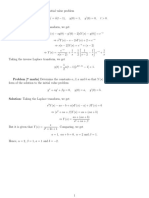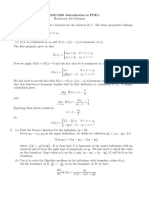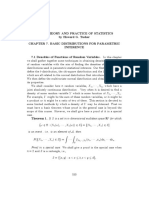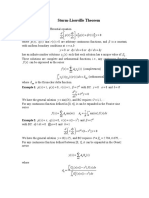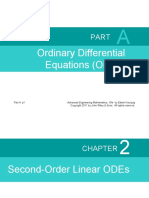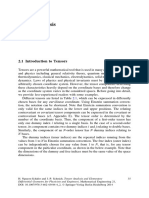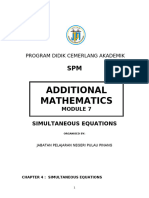MATH 1005A - Notes 1 Reduction of Order
MATH 1005A - Notes 1 Reduction of Order
Uploaded by
Jacek Filip KhanCopyright:
Available Formats
MATH 1005A - Notes 1 Reduction of Order
MATH 1005A - Notes 1 Reduction of Order
Uploaded by
Jacek Filip KhanOriginal Title
Copyright
Available Formats
Share this document
Did you find this document useful?
Is this content inappropriate?
Copyright:
Available Formats
MATH 1005A - Notes 1 Reduction of Order
MATH 1005A - Notes 1 Reduction of Order
Uploaded by
Jacek Filip KhanCopyright:
Available Formats
MATH 1005A - Notes 1
Reduction of Order
Consider a linear, second-order, homogeneous equation in standard form,
y 00 + p(x)y 0 + q(x)y 0 = 0:
Suppose that one solution y1 is known. Then a second, independent solution y2 is obtained
by letting y2 (x) = u(x)y1 (x); u(x) to be determined.
y2 = uy1 ) y20 = u0 y1 + uy10 ; y 00 = u00 y1 + 2u0 y10 + uy100 ;
so y2 is a solution if and only if
[u00 y1 + 2u0 y10 + uy100 ] + p(x)[u0 y1 + uy10 ] + q(x)[uy1 ] = 0;
i.e.,
u[y100 + p(x)y10 + q(x)y1 ] + u00 y1 + 2u0 y10 + p(x)u0 y1 = 0:
Since y1 is a solution, y100 + p(x)y10 + q(x)y1 = 0. Thus, y2 is a solution if and only if
u00 y1 + u0 [2y10 + p(x)y1 ] = 0;
i.e.,
u00 2y10 + p(x)y1 y10
= ¡ = ¡2 ¡ p(x):
u0 y1 y1
Integration with respect to x then gives
Z
0
ln ju j = ¡2 ln jy1 j ¡ p(x) dx:
¡2 1
Taking the exponential of both sides and using the fact that e¡2 ln jy1 j = eln jy1 j = , we
y12
obtain
1 ¡ R p(x) dx 1 ¡ R p(x) dx
ju0 j = e ; or u0
= § e :
y12 y12
Taking the plus sign and integrating once more, we obtain
Z
1 ¡ R p(x) dx
u(x) = e dx:
y12
Since
1 ¡ R p(x) dx
e 6= 0;
y12
u(x) is not a constant, hence y1 = erx and y2 = u(x)erx are linearly independent.
For the equation ay 00 + by 0 + cy = 0 with b2 ¡ 4ac = 0; y = erx ) ar2 + br + c = 0 )
p
¡b § b2 ¡ 4ac b b
r= =¡ ) y1 = erx = e¡ 2a x :
2a 2a
2
In standard form, the equation is
b c b
y 00 + y 0 + y = 0; with p(x) = :
a a a
Thus, by reduction of order,
1 ¡ R p(x) dx 1 ¡R b 1 b 1
u0 = e = e a
dx
= e¡ a x = e2rx = 1 ) u(x) = x ) y2 = xerx :
y12 e2rx e2rx e2rx
You might also like
- Mathematics-II (MA1201) Ordinary Differential Equations Ratikanta BeheraDocument6 pagesMathematics-II (MA1201) Ordinary Differential Equations Ratikanta BeheraAnurag BanerjeeNo ratings yet
- 2.2 Second Order Linear Homogeneous ODE With Constant CoefficientsDocument7 pages2.2 Second Order Linear Homogeneous ODE With Constant CoefficientsBhupi.SamNo ratings yet
- Sturm's Separation and Comparison TheoremsDocument5 pagesSturm's Separation and Comparison TheoremsKuldeep KumarNo ratings yet
- Major SolutionsDocument8 pagesMajor Solutionsjainnupur321No ratings yet
- HW 13 ADocument8 pagesHW 13 AAjay Varma100% (5)
- Differential Equations (MA 1150) : SukumarDocument41 pagesDifferential Equations (MA 1150) : SukumarMansi NanavatiNo ratings yet
- Calculus: Double IntegralsDocument3 pagesCalculus: Double IntegralsBala BalajiNo ratings yet
- PDE Assig-1Document12 pagesPDE Assig-1sahlewel weldemichaelNo ratings yet
- Ibubqnhc 0 Ilmj 3 N Ymlj TIFDocument30 pagesIbubqnhc 0 Ilmj 3 N Ymlj TIFdjm07034No ratings yet
- First and Second Order OdesDocument5 pagesFirst and Second Order OdesShhubhamGuptaNo ratings yet
- Odes PDFDocument5 pagesOdes PDFShhubhamGuptaNo ratings yet
- Lecture 19Document5 pagesLecture 19Ritik KumarNo ratings yet
- First Order ODE (Online Copy)Document24 pagesFirst Order ODE (Online Copy)saveNo ratings yet
- ODE: Assignment-4Document9 pagesODE: Assignment-4ShamNo ratings yet
- @M @y @N @X @M @y @N @XDocument3 pages@M @y @N @X @M @y @N @XSemih ÇınarNo ratings yet
- Solutions Chapter 1Document7 pagesSolutions Chapter 1ALLEN TANAKA MUZORERANo ratings yet
- De Lecture6Document11 pagesDe Lecture6bishwadiprajpNo ratings yet
- Nonlinear Equations Reduction of Order-When y or X Are MissingDocument3 pagesNonlinear Equations Reduction of Order-When y or X Are Missingakabaka123No ratings yet
- Ecuaciones Diferenciales ParcialesDocument5 pagesEcuaciones Diferenciales ParcialesAdrián Martínez BelmontesNo ratings yet
- Regular and Irregular Singular Points of Odes: 0 P (X) 0, P (X) 1Document4 pagesRegular and Irregular Singular Points of Odes: 0 P (X) 0, P (X) 1Siti MaimunahNo ratings yet
- Engineering Mathematics (3) Lecture Notes 2.1Document7 pagesEngineering Mathematics (3) Lecture Notes 2.1wawaiNo ratings yet
- Chapter 02 2nd-Order Linear ODEsDocument18 pagesChapter 02 2nd-Order Linear ODEsSider HsiaoNo ratings yet
- Exercices de Math Ematiques: Structure of Vector SpaceDocument15 pagesExercices de Math Ematiques: Structure of Vector Spaceنور هدىNo ratings yet
- App3 Chapter 2Document11 pagesApp3 Chapter 2Mesay NiusNo ratings yet
- Aksum University College of Natural & Computational Sciences Department of Mathematics Assignment-1 of Partial Differential EquationsDocument11 pagesAksum University College of Natural & Computational Sciences Department of Mathematics Assignment-1 of Partial Differential Equationssahlewel weldemichaelNo ratings yet
- MATH 1005B: Winter 2015 Test One (Version A) SolutionsDocument3 pagesMATH 1005B: Winter 2015 Test One (Version A) SolutionssadorNo ratings yet
- PageNo 7 16 Rohit TiwariDocument3 pagesPageNo 7 16 Rohit TiwariManas HiremathNo ratings yet
- Course Summary Notes MATH2038Document7 pagesCourse Summary Notes MATH2038chunyi20198No ratings yet
- Chap1notes SolDocument8 pagesChap1notes Solrahul gunjalNo ratings yet
- Second Order Differential Equations: Dr. Suresh Kumar, BITS PilaniDocument16 pagesSecond Order Differential Equations: Dr. Suresh Kumar, BITS PilaniRahul SharmaNo ratings yet
- Sturm-Liouville EquationsDocument16 pagesSturm-Liouville Equationsvanaj123No ratings yet
- Solution SetDocument300 pagesSolution Setqwerty12311No ratings yet
- MATH 218 Fall 2009 Assignment 1 Solutions: Part I: Problems From Problem Set 1 in The Course NotesDocument7 pagesMATH 218 Fall 2009 Assignment 1 Solutions: Part I: Problems From Problem Set 1 in The Course NotesjcywuNo ratings yet
- HW 3 SolDocument4 pagesHW 3 SolSuper NezhNo ratings yet
- Tema 6Document16 pagesTema 6guillermo araus pérezNo ratings yet
- Lec 4 Second Order Linear Differential EquationsDocument51 pagesLec 4 Second Order Linear Differential EquationsTarun KatariaNo ratings yet
- First Order Differential Equations: BCCC Tutoring CenterDocument4 pagesFirst Order Differential Equations: BCCC Tutoring CenterCarloNo ratings yet
- Solutions Set 7Document6 pagesSolutions Set 7amircsgo4747No ratings yet
- Chap 07Document35 pagesChap 07Giancarlo Libreros LondoñoNo ratings yet
- Tutorial 5 SolutionsDocument3 pagesTutorial 5 SolutionsAkshay NarasimhaNo ratings yet
- Class Test 1 2020 With Answers PDFDocument6 pagesClass Test 1 2020 With Answers PDFPeper12345No ratings yet
- PDE LaplaceDocument13 pagesPDE Laplaceorbe.2253No ratings yet
- Chapter 5.4: Regular Singular Points: We Now Study Solutions of + Q (X) y + R (X) y 0 Near A Regular Singular PointDocument13 pagesChapter 5.4: Regular Singular Points: We Now Study Solutions of + Q (X) y + R (X) y 0 Near A Regular Singular Pointpartha4uNo ratings yet
- Linear Algebra and Differential Equations: Sartaj Ul HasanDocument21 pagesLinear Algebra and Differential Equations: Sartaj Ul HasanVijayNo ratings yet
- Homework 2Document4 pagesHomework 2Abegail LorillaNo ratings yet
- Lecture 1: Newton Forward and Backward Interpolation: M R Mishra May 9, 2022Document10 pagesLecture 1: Newton Forward and Backward Interpolation: M R Mishra May 9, 2022MANAS RANJAN MISHRANo ratings yet
- Tutorial 1Document2 pagesTutorial 1Khushi BaghelNo ratings yet
- Pas C2 MSDocument4 pagesPas C2 MSsunnyy53059155No ratings yet
- Test 1 SolutionsDocument3 pagesTest 1 SolutionsFrantz ClermontNo ratings yet
- Assignment 5 (11-13)Document13 pagesAssignment 5 (11-13)Midhun MNo ratings yet
- RudinDocument26 pagesRudinqwsx098No ratings yet
- Homework 8: Solutions: Change Order and EvaluateDocument10 pagesHomework 8: Solutions: Change Order and EvaluateAhmad NNo ratings yet
- Sturm Liouville TheoremDocument1 pageSturm Liouville TheoremNoraedddNo ratings yet
- 280hwalls19 PDFDocument69 pages280hwalls19 PDFArvind KumarNo ratings yet
- Lecture 8Document7 pagesLecture 8Vikas PandeyNo ratings yet
- Mathematics 1St First Order Linear Differential Equations 2Nd Second Order Linear Differential Equations Laplace Fourier Bessel MathematicsFrom EverandMathematics 1St First Order Linear Differential Equations 2Nd Second Order Linear Differential Equations Laplace Fourier Bessel MathematicsNo ratings yet
- Transformation of Axes (Geometry) Mathematics Question BankFrom EverandTransformation of Axes (Geometry) Mathematics Question BankRating: 3 out of 5 stars3/5 (1)
- Functional Operators, Volume 2: The Geometry of Orthogonal SpacesFrom EverandFunctional Operators, Volume 2: The Geometry of Orthogonal SpacesNo ratings yet
- Green's Function Estimates for Lattice Schrödinger Operators and ApplicationsFrom EverandGreen's Function Estimates for Lattice Schrödinger Operators and ApplicationsNo ratings yet
- Solving ODE-BVP Using The Galerkin's MethodDocument14 pagesSolving ODE-BVP Using The Galerkin's MethodSuddhasheel Basabi GhoshNo ratings yet
- Subtracting A Number Is The Same As Adding Its Opposite (Also Called Its Additive Inverse) - ToDocument1 pageSubtracting A Number Is The Same As Adding Its Opposite (Also Called Its Additive Inverse) - ToMarkvincent FernandezNo ratings yet
- Trig Cheat SheetDocument4 pagesTrig Cheat Sheetapi-284574585No ratings yet
- Ordinary Differential Equations (Odes) : Part A P1Document150 pagesOrdinary Differential Equations (Odes) : Part A P1hamed farzanehNo ratings yet
- Math 10 Pa Q2module 1 Weeek 1-2Document3 pagesMath 10 Pa Q2module 1 Weeek 1-2Alleah GeveroNo ratings yet
- Abstract AlgebraDocument5 pagesAbstract AlgebraJose Luis CondoriNo ratings yet
- DPP A1 - Solutions PDFDocument4 pagesDPP A1 - Solutions PDFmanoj sharma100% (1)
- QA 12 Numbers-2Document22 pagesQA 12 Numbers-2Sunit SomuNo ratings yet
- Mathematics-II (MATH F112) : Linear Algebra and Complex AnalysisDocument70 pagesMathematics-II (MATH F112) : Linear Algebra and Complex AnalysisReetik RanjanNo ratings yet
- Evaluation Exam No.1 Manila Questionnaire CORRECT ANSWERSDocument5 pagesEvaluation Exam No.1 Manila Questionnaire CORRECT ANSWERSJohn RoaNo ratings yet
- Taylor Schermers Unit 3 Meadows or Malls ReportDocument7 pagesTaylor Schermers Unit 3 Meadows or Malls Reportapi-481780857No ratings yet
- MatricesDocument12 pagesMatricesVenkat GowdaNo ratings yet
- Pre-Assessment in Module 1Document4 pagesPre-Assessment in Module 1Ralph Rexor Macarayan BantuganNo ratings yet
- 1C Program For Gauss Elimination Method - Code With CDocument4 pages1C Program For Gauss Elimination Method - Code With CbcshendeNo ratings yet
- Applied MathsDocument197 pagesApplied MathsRonak100% (1)
- Errata Crypto5e 0612Document3 pagesErrata Crypto5e 0612Babak KarimiNo ratings yet
- Tensor Analysis SpringerDocument66 pagesTensor Analysis SpringerAndré AlbuquerqueNo ratings yet
- Fundamental Group and Covering Spaces: The FactsDocument14 pagesFundamental Group and Covering Spaces: The FactsНикола МутавџићNo ratings yet
- MATH 1 (MODULE 1.1) - StudentDocument5 pagesMATH 1 (MODULE 1.1) - StudentXenos ArcanaNo ratings yet
- Revised Damath Guidelines 2019Document4 pagesRevised Damath Guidelines 2019JONESSA GAMBITO100% (3)
- Topic 7: Matrices and Determinants ObjectivesDocument5 pagesTopic 7: Matrices and Determinants ObjectivesMD ROKNUZZAMANNo ratings yet
- This Study Resource Was: MCV4U Exam ReviewDocument9 pagesThis Study Resource Was: MCV4U Exam ReviewNathan WaltonNo ratings yet
- Fnding The Digit in The Unit's PlaceDocument18 pagesFnding The Digit in The Unit's PlaceSagar PatilNo ratings yet
- Advanced Ps SamplesDocument12 pagesAdvanced Ps SamplesStuart ClarkNo ratings yet
- Infinite Series and Differential Equations: Nguyen Thieu HuyDocument26 pagesInfinite Series and Differential Equations: Nguyen Thieu HuyTùng NguyễnNo ratings yet
- Numbers - Past Paper Questions - 02Document30 pagesNumbers - Past Paper Questions - 02Rama Krishna TurayiNo ratings yet
- Solving Rational Equation and InequalitiesDocument2 pagesSolving Rational Equation and InequalitiesVIC VINCENT N. VILLAVER100% (1)
- Avenues Math PackDocument24 pagesAvenues Math PackBhavik LodhaNo ratings yet
- 2.07) Add Math Module 07 (Simultaneous Equations)Document10 pages2.07) Add Math Module 07 (Simultaneous Equations)FARHAN BIN OTHMAN SEMAN MoeNo ratings yet
- Using Substitution Homogeneous and Bernoulli Equations: BCCC Tutoring CenterDocument3 pagesUsing Substitution Homogeneous and Bernoulli Equations: BCCC Tutoring CenterEuwan Tyrone PriasNo ratings yet



